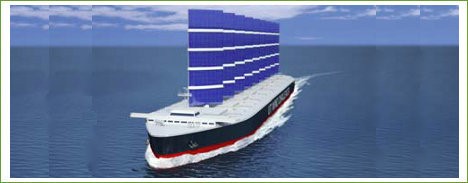Source: ecogeek.org
Published: September 4, 2012
Written by Philip Proefrock

With global production and distribution of goods a reality of 21st Century life, cargo ships are ubiquitous. They bring goods to consumers all over the world, and more and more ships are transporting goods and raw materials, all while burning some of the most polluting fuels. A recent article about the rise of wind-powered designs for cargo vessels notes that, “If the world’s shipping fleet were a country, it would be the world’s sixth leading emitter of greenhouse gases.” So there is lots of good to be done with improving the efficiency of cargo ships. And a number of companies are taking steps in that direction.
At the University of Tokyo, researchers are working on a design for a ship that uses rigid framework and fiber-reinforced plastic instead of canvas for sails. These high-tech sails can be flown, much more like an airplane wing, increasing the efficiency with which they propel the ship. And, when the vessel reaches port, the sails telescope down upon themselves, to allow free access to the decks and cargo without the interference of masts and sail rigging lines getting in the way.
Among the companies working to commercialize wind-powered cargo, B9 Shipping has recently tested a model of their 3,000 ton vessel. Although this is far smaller than the largest cargo freighters, which can have more than 100 times the cargo capacity, it is a first step in developing the technology and proving its financial viability.
When we wrote about B9 in 2010, the expected cost of the prototype vessel was just under $25 million. The New York Times is now reporting that the company is seeking $45 million in financing to build their prototype. (This may not be an entirely equal comparison, since the financing the company is seeking may include more than just the capital construction costs for the ship.)
Many of these vessels will not be solely wind powered, even at sea. Not unlike automobiles, where gas-electric hybrids first broke down boundaries and showed the workability of alternative systems, these ships will also be hybrids. B9 plans to use engines that burn bio-methane instead of fossil fuel as a secondary propulsion system.
image via: University of Tokyo News
hat tip to: @paolobacigalupi
